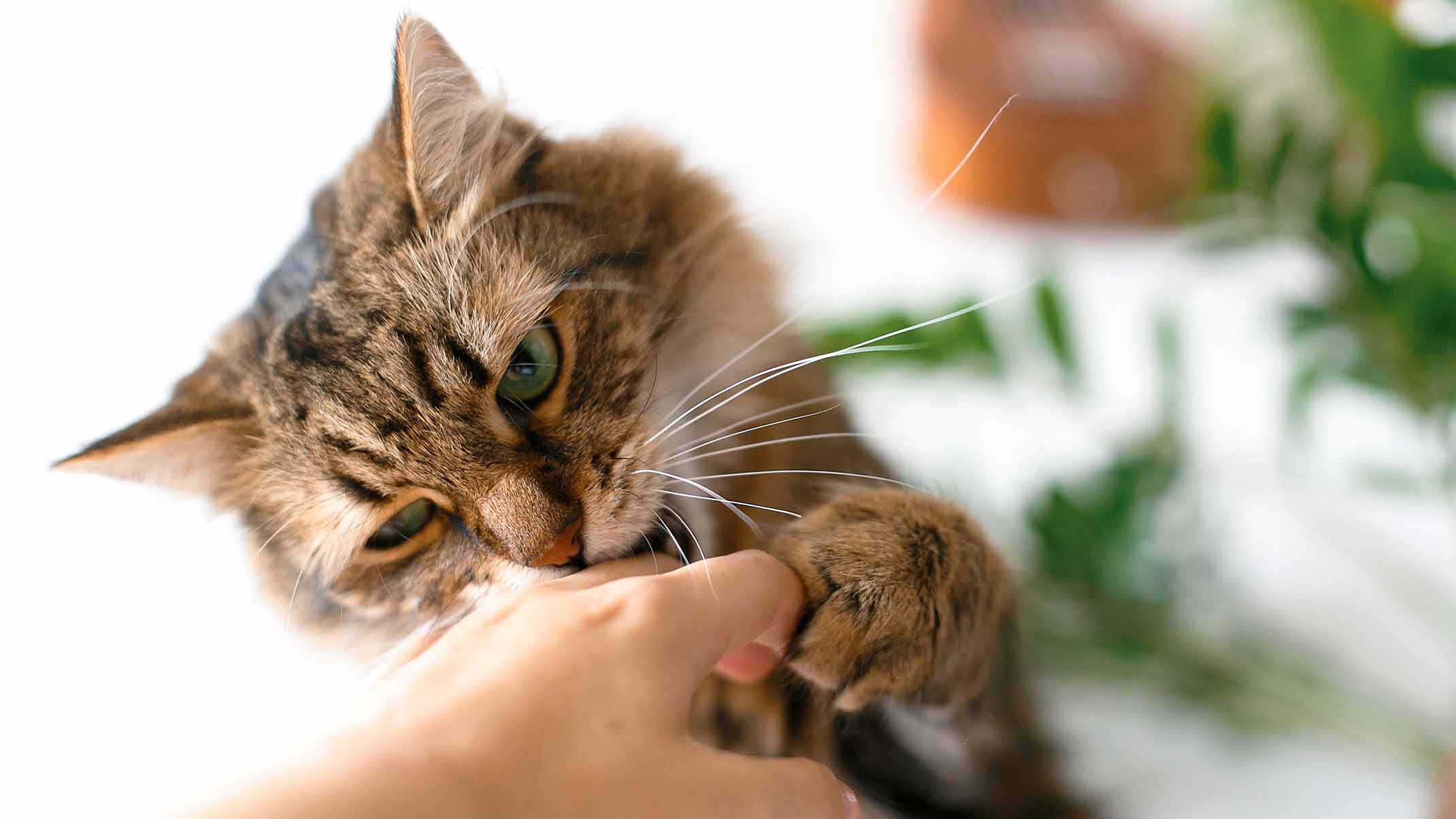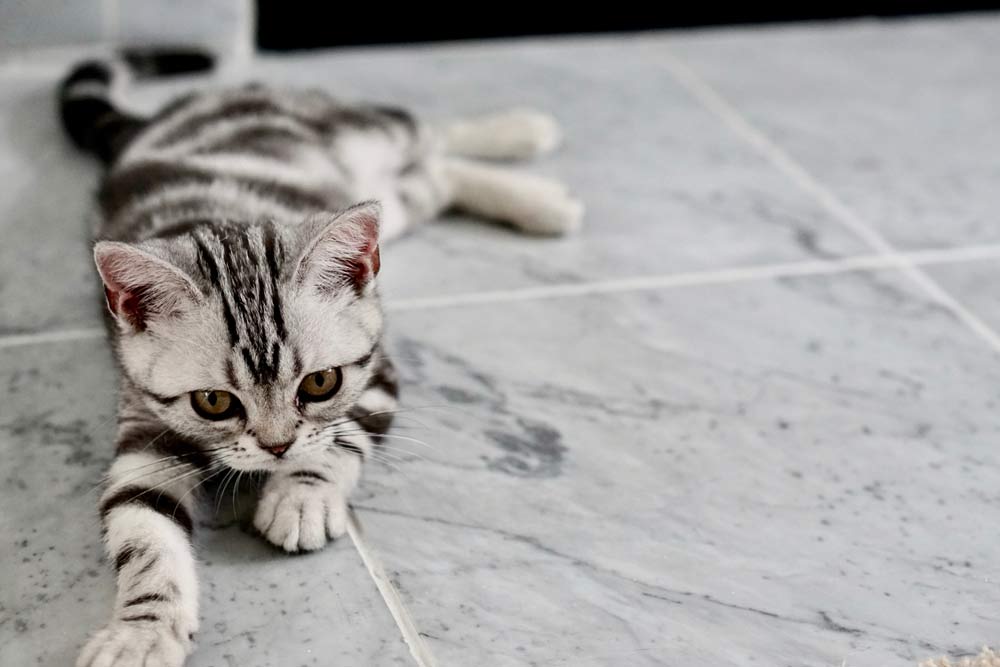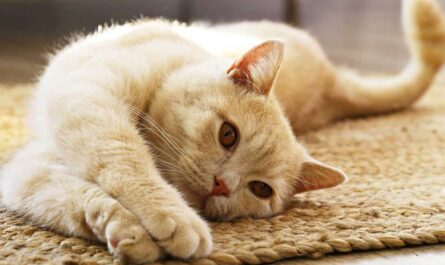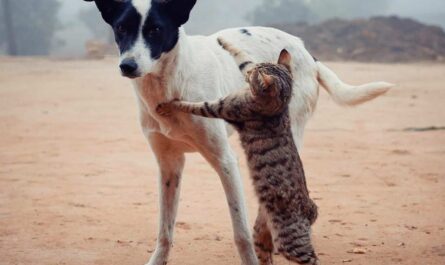Why does my cat bite me? You’re having a delightful cuddle session with your feline friend, their soft purrs a symphony of contentment. You reach out to stroke their head, and suddenly – sharp little teeth meet your skin! Confusion and a tinge of frustration cloud your moment of joy. This unexpected chomp can leave even the most devoted cat owner scratching their head. After all, our feline companions are enigmatic creatures, and their communication style isn’t always as clear-cut as a barking dog. Fear not, fellow cat enthusiasts! This comprehensive guide delves into the complexities of cat biting, transforming those bewildering nips into understandable messages.
We’ll embark on a journey to decode the various reasons behind your cat’s biting behavior. By exploring the common causes, we’ll equip you with effective solutions tailored to the underlying issue. From playful nips to territorial swats, you’ll gain the knowledge to navigate these situations with confidence. We’ll also explore strategies for preventing future biting incidents, emphasizing the power of positive reinforcement in cultivating a harmonious relationship with your cat. Remember, a happy cat is a less bitey cat! Finally, we’ll delve into the importance of understanding your cat’s unique communication cues, paving the way for a future filled with purrs, head boops, and, most importantly, bite-free interactions. So, grab your favorite catnip-infused toy (because playtime is key!), and let’s unlock the secrets behind those feline nips!
Whiskered Worries: Understanding Why Your Cat Bites
Cats are enigmatic creatures, capable of bringing immense joy with their playful antics and purrs of contentment. However, sometimes those playful swats can escalate into unexpected nips or bites. While a feline friend delivering a love tap might seem alarming, understanding the reasons behind these nips can help you transform your relationship into one of mutual trust and respect. This section dives into the various reasons why cats bite, empowering you to decipher your cat’s communication and build a harmonious bond.
Playful Predators: When Hunting Instincts Take Over
Kittens are bundles of boundless energy, exploring the world with curious paws and playful nips. This biting behavior often stems from their natural hunting instincts. Imagine tiny lions stalking imaginary prey, pouncing, and delivering playful bites. While adorable in small doses, these nips can become uncomfortable as your kitten matures.
Here’s how to navigate this stage:
- Provide Appropriate Playthings: Redirect your kitten’s hunting instincts towards engaging toys like feathery wands or catnip-filled mice. Interactive play sessions not only provide an outlet for their energy but also help strengthen your bond.
- Ouch-Free Training: When your kitten nips, yelp,s or squeals in a high-pitched voice (similar to a startled kitten). This sudden noise disrupts the play and communicates that the biting is unwelcome. Immediately withdraw your attention and disengage from play for a short time. Kittens learn quickly, and with consistent redirection, they’ll associate gentle play with continued interaction.
Remember: Patience is key! Kitten biting is a natural behavior, and consistent, positive reinforcement will help them learn appropriate ways to interact.
Overstimulation Overload: When Too Much Becomes Too Much
While cats crave affection, sometimes excessive petting or playtime can backfire. Just like us, they have a tolerance for stimulation, and exceeding that limit can lead to overstimulation. When a cat feels overwhelmed, a playful nip might be their way of saying “Enough is enough.”
Here are some signs your cat might be overstimulated:
- Twitching tail: A rapidly twitching tail is often a sign of feline annoyance.
- Flattened ears: Pay attention to your cat’s body language. Flattened ears against the head signal discomfort.
- Dilated pupils: Wide eyes can indicate arousal, but in conjunction with other signs, they might signal overstimulation.
If you notice these signs, stop petting or playing immediately and give your cat some space to calm down. Learn to recognize your cat’s individual cues and adjust your interaction style accordingly.
Fear and Anxiety: When Bites Stem from Self-Defense
Cats are creatures of habit, and sudden changes or unfamiliar situations can trigger anxiety. If your cat feels scared, threatened, or cornered, they might resort to biting as a defensive mechanism.
Here are some ways to create a safe and secure environment for your cat:
- Provide Hiding Spots: Cats feel secure having a designated safe space to retreat to when overwhelmed. Offer cozy cat beds, cardboard boxes, or cat trees with cubbyholes.
- Respect Boundaries: Don’t force interaction on your cat. Allow them to approach you on their terms and create a trusting relationship through positive reinforcement.
- Introduce New Elements Gradually: When introducing new pets, people, or furniture, do so slowly and in a controlled manner. This allows your cat to adjust at their own pace and minimizes anxiety.
Remember: A fearful cat is more prone to biting. Building trust and creating a safe haven will go a long way in preventing bites caused by anxiety.
Deciphering Your Cat’s Messages: Understanding Signs Before a Nip
Cats are masters of communication, but unlike barking dogs, their language is often subtle. This section delves into some key signs that your feline friend might be sending you before a potential nip. By understanding these signals, you can prevent bites and foster a more harmonious relationship with your cat.
Tail Talk: Unraveling the Mystery of the Waving Wand
The tail is a window to a cat’s emotional state. Learning to “read” your cat’s tail wags and flicks can help you anticipate their mood and avoid misunderstandings:
- The Twitchy Tail: A rapidly twitching tail, especially if accompanied by flattened ears or a tense posture, can indicate irritation or nervousness. If you see this sign, it’s best to give your cat some space and avoid interacting with them until they calm down.
- The Swishing Tail: A slow, swishing tail can be a sign of indecision or mild annoyance. Proceed with caution and pay attention to other body language cues to gauge your cat’s mood.
- The Tucked Tail: A tucked tail tucked low between the legs is a universal sign of fear or submission. If your cat displays this posture, back off and avoid any actions that might further frighten them.
Remember: A relaxed, upright tail with a slight curve at the tip is generally a good sign, indicating that your cat is content and comfortable.
Flattened Ears: Nature’s Warning Sign
Imagine encountering someone with furrowed brows and crossed arms. Just like humans, cats flatten their ears to communicate displeasure or potential aggression. When you see flattened ears, particularly combined with hissing or growling, it’s a clear warning sign that your cat feels threatened or cornered. Respect their boundaries and give them space to retreat.
Seeing Spots: Decoding Dilated Pupils
Cat eyes are captivating, and their pupils change size depending on the lighting and their emotional state. While dilated pupils can sometimes indicate excitement or playfulness, they can also be a sign of fear or aggression. Consider the context of the situation:
- Playtime pupils: If your cat’s pupils are dilated while they’re playfully batting at a toy, it likely signifies their enjoyment.
- Fearful pupils: If your cat’s pupils are dilated when they encounter a new person or a strange sound, it might indicate fear. Provide them with a safe hiding spot and avoid forcing interactions.
- Angry eyes: In conjunction with other signs like flattened ears and hissing, dilated pupils can indicate aggression. Back off slowly and avoid making eye contact.
Remember: Pay attention to other body language cues alongside dilated pupils to get a clearer understanding of your cat’s mood.
Hissing and Growling: Nature’s “Stop” Sign
Hissing and growling are unmistakable warnings from your cat. These vocalizations clearly communicate that they are unhappy, scared, or feeling threatened. If you hear your cat hissing or growling, stop whatever interaction is happening and give them space. Respecting these warnings helps prevent bites and builds trust with your feline friend.
Decoding the Nibble: Understanding Why Your Cat Bites and Solutions to Foster Harmony
Cats are enigmatic creatures, full of purrs and playful swats. But sometimes, those playful swats can turn into unexpected nips or bites. While a cat bite can be startling, understanding the reason behind it is the first step towards creating a more peaceful coexistence with your feline friend. This section delves into the common causes of cat biting and equips you with solutions to foster a harmonious relationship.
Playful Antics: Redirecting the Bite with Engaging Toys
Kittens explore the world with their mouths, and play biting is a natural part of their development. However, what might seem like a gentle nip to a kitten can become a painful bite as your cat matures. Here’s how to address playful biting:
- Tempt with Toys, Not Fingers: Avoid using your hands or fingers as toys during playtime. This can teach your kitten that hands are acceptable targets for biting. Instead, invest in a variety of engaging toys like feathery wands, catnip-filled mice, or balls that roll and crinkle. These toys provide a more appropriate outlet for your cat’s hunting instincts and playful energy.
- The Power of Positive Reinforcement: When your cat interacts with their toys appropriately, shower them with praise and treats! This positive reinforcement strengthens the association between toys and playtime, discouraging them from using your hands as playthings.
- Time Out for Teeth: If your cat does land a playful bite, don’t swat or yell. Instead, immediately end playtime. This short interruption communicates that biting is not tolerated and encourages them to find gentler ways to interact.
Remember: Playtime should be a positive experience for both you and your cat. By providing engaging toys and redirecting unwanted biting, you can ensure playtime strengthens your bond without any unforeseen nips.
Respecting Boundaries: Recognizing Signs of Overstimulation
Cats, despite their independent nature, can become overstimulated during petting or play sessions. This overstimulation can sometimes manifest as biting or scratching. Here’s how to recognize the signs and prevent a bite:
- The Tail Tells the Tale: A twitching tail, flattened ears, or dilated pupils are all signs your cat might be feeling overwhelmed. Pay attention to your cat’s body language and stop petting or playing immediately if you notice these signals.
- Respect the Retreat: If your cat tries to swat at your hand or disengage from petting, allow them to retreat to a safe space. Forcing interaction can increase their stress and potentially lead to biting.
- Shorter Sessions, More Frequent: Instead of long petting sessions, opt for shorter bursts of affection throughout the day. This allows your cat to regulate their level of stimulation and reduces the risk of overstimulation and biting.
Remember: Reading your cat’s body language is key to preventing bites caused by overstimulation. Respect their boundaries, and your petting sessions will be filled with happy purrs instead of startled yelps.
Building Trust and Security: Creating a Safe Haven for Your Feline Friend
Fearful or anxious cats might resort to biting as a way to defend themselves. Here’s how to create a safe and secure environment that fosters trust and minimizes the risk of fear-based biting:
- Provide Plenty of Hiding Spots: Cats feel secure having a safe space to retreat to when feeling overwhelmed. Offer cubbyholes, cat trees with platforms, or cardboard boxes strategically placed around your home.
- Introduce New Elements Slowly: New pets, furniture, or loud noises can all be stressful for a fearful cat. Introduce any changes gradually, allowing your cat time to adjust and feel safe in their environment.
- Positive Reinforcement is Key: Create positive associations with interaction. Offer treats or praise when your cat approaches you calmly. Avoid grabbing, scolding, or cornering them, as this can worsen their anxiety.
Remember: Building trust with a fearful cat takes time and patience. By creating a safe haven, introducing changes slowly, and using positive reinforcement, you can create a trusting bond and minimize fear-based biting.
Seeking Veterinary Guidance: Ruling Out Medical Causes
In some cases, biting can be a sign of an underlying medical condition, such as dental pain, urinary tract infections, or hyperthyroidism. If you suspect a medical cause for your cat’s biting, schedule a visit with your veterinarian for a proper diagnosis and treatment plan.
Remember: Consulting your veterinarian is crucial if your cat exhibits sudden changes in behavior, including biting. Ruling out any medical causes can ensure you’re addressing the root of the problem and creating a happier, healthier feline companion.

From Nips to Nuzzles: Building a Bite-Free Bond with Your Cat
Cats are enigmatic creatures, capable of bringing immense joy and purrfect companionship into our lives. However, sometimes those moments of playful exuberance can morph into unexpected nips or bites. While a feline friend’s occasional nip might not be a cause for alarm, understanding the reasons behind this behavior and implementing preventative measures can foster a harmonious relationship built on mutual respect and trust.
This section delves into the fascinating world of feline communication and explores strategies to create a bite-free future with your furry companion. By incorporating positive reinforcement training, engaging playtime techniques, and respecting your cat’s unique communication cues, you can transform those playful nips into gentle head nudges and blissful purrs.
The Power of Positive Reinforcement: Shaping Desirable Behaviors
Imagine this: you’re enjoying a cuddle session with your cat when, seemingly out of the blue, they playfully nip at your hand. While this might surprise you, it’s important to remember that punishment is rarely the answer. Instead, positive reinforcement training can effectively discourage biting and encourage desired behaviors:
- Reward the Good Stuff: When your cat interacts with you gently, shower them with praise and treats! This positive reinforcement strengthens the association between gentle behavior and positive outcomes. Over time, your cat will learn that gentle interaction is the key to getting the attention and affection they crave.
- Clicker Training (Optional): Clicker training can be a fun and effective way to reinforce positive behavior. A clicker is a small handheld device that makes a distinct clicking sound. Pair the click with a treat or praise immediately following a desired behavior, like a gentle nudge or head bump. This helps your cat understand exactly what behavior earns them a reward.
Remember: Consistency is key! Use positive reinforcement techniques consistently during playtime, petting sessions, and everyday interactions to create a lasting impact on your cat’s behavior.
Playtime Power: Engaging Your Cat’s Inner Hunter
Cats are natural-born hunters with a strong prey drive. When this instinct isn’t adequately channeled through play, they might resort to using their human companions as living scratching posts or playthings – sometimes resulting in unintentional nips. The solution? Engaging playtime that mimics hunting and stalking behaviors:
- Interactive Toys are the Way to Go: Ditch the feather toys that dangle lifelessly. Opt for interactive toys like wand toys with feathers or mice that you can wiggle and dart around to mimic the erratic movements of prey. This ignites your cat’s hunting instincts and provides a healthy outlet for their energy.
- Rotate the Fun: Cats are curious creatures, and keeping their playtime interesting is essential. Rotate between a variety of toys to prevent boredom. Consider introducing puzzle feeders or treat dispensers that challenge your cat’s problem-solving skills and provide mental stimulation.
Remember: Schedule regular playtime sessions throughout the day, especially when your cat seems restless or energetic. A tired cat is a less bite-prone cat!
Petting on Their Terms: Respecting Cat Communication Cues
Cats are masters of communication, and understanding their body language and vocalizations is crucial to building a trusting bond. Here’s how to decipher their cues and avoid situations that might lead to nipping:
- Read the Body Language: A swishing tail, flattened ears, or dilated pupils are all signs that your cat might be feeling overstimulated or stressed. If you notice these signs while petting them, back off and give them some space. A slow blink, however, is a sign of contentment and affection.
- Respect the Slow Blink: The slow blink is a feline term of endearment. If your cat slowly blinks at you, return the gesture! This reinforces trust and strengthens your bond.
- Initiation is Key: Allow your cat to initiate petting sessions. This empowers them and prevents them from feeling overwhelmed by unwanted affection. Once they approach you for cuddles, start with gentle strokes behind the ears or chin, and pay attention to their body language to gauge their comfort level.
Remember: Cats are individuals with varying preferences. Some cats crave constant attention, while others prefer short bursts of affection. Respecting your cat’s unique communication style is key to building a loving and bite-free relationship.
By incorporating these positive strategies into your daily interactions with your cat, you can create a future filled with purrs, head boops, and gentle nuzzles, transforming those playful nips into a distant memory.
Beyond the Nip: Deciphering Why Your Cat Bites and Building a Purrfect Bond
Cats, with their independent spirit and undeniable charm, can bring immeasurable joy to our lives. However, those playful nips can sometimes turn into surprising owies, leaving you wondering: “Why did my cat bite me?”. This section delves into the reasons behind feline nibbles and scratches, equipping you with the knowledge to foster a trusting and happy relationship with your whiskered companion.
Cracking the Code: Understanding Your Cat’s Communication
Cats are masters of nonverbal communication. A twitch of the tail, a flick of the ear – these seemingly subtle signs can hold a wealth of information about your cat’s mood and intentions. Learning to “speak cat” is key to understanding why they might resort to biting:
- Playful Swats: Kittens often explore the world with their mouths and paws. Those playful nips and swats are a normal part of kitten development, mimicking hunting behavior. While adorable, it’s important to establish boundaries early on to prevent these playful nips from escalating into biting as your cat matures.
- Overstimulation Alert: Some cats enjoy petting, but even the most cuddly feline can reach their limit. Signs of overstimulation include flattened ears, a swishing tail, and a twitching nose. If you notice these signs while petting your cat, stop the interaction and give them some space to avoid a potential bite.
- Fear and Anxiety: A scared or anxious cat might bite as a defensive mechanism. This could be due to a new pet in the house, a loud noise, or even a change in their routine. Creating a safe space for your cat and providing hiding spots can help them feel more secure.
- Attention Seeking: Has your cat bitten you right when you sit down with a book? Sometimes, a bite is simply a meow in disguise! If your cat seems to bite when they want attention, ensure they have engaging toys and scratching posts to redirect their energy. Positive reinforcement with treats or praise, when they interact with you appropriately, can also discourage biting for attention.
Remember: Understanding your cat’s body language is crucial to preventing bites. Pay attention to their ears, tail position, and vocalizations to anticipate their mood and avoid situations that might trigger a bite.
Patience is the Purrfect Ingredient: Building Trust Through Positive Reinforcement
Building a trusting relationship with your cat takes time and consistent positive reinforcement. Here are some tips to keep in mind:
- Gentle Interactions: Handle your cat gently, avoiding rough play or grabbing them when they’re startled. Positive interactions build trust and create a more harmonious relationship.
- Respect Their Boundaries: Pay attention to your cat’s cues. If they seem withdrawn or swat at you, give them space. Respecting their boundaries shows them you care about their comfort.
- Reward Positive Behavior: When your cat interacts with you playfully without biting, shower them with praise and treats! This positive reinforcement strengthens the association of gentle play with positive outcomes.
- Provide Enrichment: Cats are curious creatures who crave mental stimulation. Interactive toys, puzzle feeders, and scratching posts keep them engaged and prevent boredom, which can sometimes lead to biting out of frustration.
Remember: Punishment is never the answer when dealing with cat bites. It can damage the trust you’re trying to build and worsen the behavior. Focus on positive reinforcement and redirection to encourage gentle interactions.
When to Seek Professional Help: Calling in the Cat Whisperer
If your cat’s biting persists despite your best efforts, it might be time to consult a certified animal behaviorist. These professionals can provide personalized training techniques and strategies to address the root cause of your cat’s biting behavior. Remember, seeking professional help is a sign of responsible pet ownership and demonstrates your commitment to creating a happy and harmonious home for both you and your feline companion. Cat accessories on Amazon
Remember: With patience, understanding, and positive reinforcement, you can build a trusting bond with your cat and minimize the chances of unexpected nips. The journey may involve a few snags along the way, but the rewards of loving companionship with your cat are well worth the effort.
Final thought: Living in Harmony: Beyond the Nip and Tuck
Those tiny needle-like teeth might leave you wondering, “Why does my cat bite me?” Understanding the reasons behind these feline nips is the first step towards creating a happier, bite-free relationship with your furry friend. This section explores the positive impact of recognizing the root of the biting behavior and implementing solutions that strengthen the bond between you and your cat.
From Frustration to Feline Fun: Understanding Leads to Solutions
Cat bites don’t have to be a source of frustration. By recognizing the communication behind the nip, you can implement positive solutions that address the underlying cause. Here’s a quick recap:
- Playful Swats: Kittens often explore the world with their mouths, and play can sometimes escalate into nipping. Providing them with plenty of appropriate toys redirects this behavior and keeps playtime enjoyable for both of you.
- Overstimulation: Cats can become overexcited during petting sessions, and a sudden nip might be their way of saying “enough.” Pay attention to your cat’s body language. Signs of overstimulation include twitching tails, flattened ears, or a stiff posture. If you notice these signs, take a break from petting and resume play later.
- Fear or Anxiety: A frightened or stressed cat might resort to biting as a form of defense. If your cat bites during unfamiliar situations or interactions, create a safe space for them and address the source of their anxiety. Health books, guides, exercises, habits, Diets, and more
Remember: Punishment is rarely effective in curbing biting behavior. Focus on positive reinforcement, rewarding your cat with treats or praise for gentle interactions.
The Purrfect Partnership: A Bond Built on Mutual Respect
Understanding your cat’s communication and implementing solutions based on that understanding is the key to building a strong, trusting bond. Imagine a future filled with playful pounces, gentle head boops, and the rhythmic purr of a contented cat curled up on your lap. This future is achievable through positive reinforcement, patience, and a newfound appreciation for your cat’s unique way of expressing themselves.
Cats are intelligent, affectionate creatures capable of forming deep bonds with their humans. By deciphering the “why” behind the bite and fostering a relationship built on mutual respect, you open the door to a lifetime of companionship filled with joy, purrs, and perhaps the occasional playful swat (hopefully directed at a toy!).
Other Interesting Articles
- Cat Flu: Symptoms, Medicine, Treatment, Text Kit, Prevention
- Cat Herpesvirus 1 (FHV-1): Causes, Symptoms, Treatment
- Do Cats Enjoy Mating? A Guide To Feline Sexual Behavior
- Benefits of a High-Protein Diet for Your Cat: A Complete Guide
- How Many Kittens Can A Cat Give Birth To: When To Worry
- Why is My Cat Drinking Much Water All of A Sudden? To-Dos
- Cat Dystocia (Difficult Birth): Causes, Symptoms, Treatment
- 23 Signs That Indicate Something is Wrong with Your Cat
- Cat Eyes Signs: 15 Things Your Cat Is Saying With Its Eyes
- How Cat Eyes Work: How to Care for Your Feline’s Eyes
- Why Does My Cat Sit On My Shoulder? Reasons, To-Dos
- Why is My Cat So Clingy? Behavior, Reasons, Solutions
- Cat Vomiting: Types, Causes, Symptoms, Treatments, Cure
- Feline Estrous Cycle: What To Expect When A Cat Is in Heat
- Weight Gain in Cats: Obesity Signs, Causes & What to Do
- 13 Ways to Tell if A Cat is Pregnant: Signs, Behavior, Guide
- Cat Pregnancy: Signs, Nipples, Behavior, Care, What To Do
- Nesting Behavior in Cats: Signs, Reasons, What To Do
- How To Help Your Cat Put Their Best Paw Forward: 12 Steps
- How To Improve Your Cat’s Behavior in 14 Systematic Steps



